Abarth Punto Evo 2012 Owner handbook (in English)
Manufacturer: ABARTH, Model Year: 2012, Model line: Punto Evo, Model: Abarth Punto Evo 2012Pages: 270, PDF Size: 3.53 MB
Page 201 of 270

200
BODY AND UNDERBODY
WARRANTY
Your car is covered by warranty against perforation due
to rust of any original element of the structure or body.
For the general terms of this warranty, refer to the
Warranty Booklet.
KNOWING
YOUR VEHICLE
SAFETY
STARTING
AND DRIVING
WARNING LIGHTS
AND MESSAGES
IN AN
EMERGENCY
MAINTENANCE
AND CARE
TECHNICAL
SPECIFICATIONS
CONTENTS
BODYWORK
PROTECTION FROM ATMOSPHERIC
AGENTS
The main causes of corrosion are the following:
❒atmospheric pollution;
❒salty air and humidity (coastal areas, or hot humid
climates);
❒seasonal environmental conditions.
The abrasive action of wind-borne atmospheric dust and
sand, as well as mud and gravel raised by other cars is
also not to be underestimated.
Abarth has used the best manufacturing technologies on
your car to effectively protect the bodywork against
corrosion.
These include:
❒painting products and systems which give the car
particular resistance to corrosion and abrasion;
❒use of galvanised (or pretreated) steel sheets, with
high resistance to corrosion;
❒spraying the underbody, engine compartment,
internal wheel housing parts and other parts with
highly protective wax products;
❒spraying of protective plastic material in the more
exposed points: underdoor, inner mudguard parts,
edges, etc...
❒Use of “open” boxed sections to prevent
condensation and pockets of moisture which could
cause rust inside.
Page 202 of 270

201
KNOWING
YOUR VEHICLE
SAFETY
STARTING
AND DRIVING
WARNING LIGHTS
AND MESSAGES
IN AN
EMERGENCY
MAINTENANCE
AND CARE
TECHNICAL
SPECIFICATIONS
CONTENTS
Detergents pollute the environment. The
vehicle should be washed in areas
equipped for collecting and cleaning the
liquid used in the washing process.
ADVICE FOR PRESERVING THE BODYWORK
Paint
Paintwork does not only serve an aesthetic purpose, but
also protects the underlying sheet metal.
Touch up abrasions and scratches immediately to
prevent rust formation. Use only original paint products
for touch-ups (see “Bodywork paint identification plate”
in the “Technical specifications” section).
Normal maintenance of paintwork consists in washing
the car: the frequency depends on the conditions and
environment where the car is used. For example, in
highly polluted areas, or if the roads are sprayed with
salt, it is wise to wash the car more frequently.
To correctly wash the vehicle, proceed as follows:
❒remove the aerial from the roof to prevent damage
to it if the car is washed in an automatic system;
❒wash the body using a low pressure jet of water;
❒wipe a sponge with a slightly soapy solution over the
bodywork, frequently rinsing with the sponge;
❒rinse well with water and dry with a jet of air or a
chamois leather.Dry the less visible parts, such as the door frames,
bonnet and the headlight frames with special care, as in
these areas water may stagnate more easily. The car
should not be taken to a closed area immediately, but
left outside so that residual water can evaporate.
Do not wash the car after it has been left in the sun or
with the bonnet hot: this may alter the shine of the
paintwork. Exterior plastic parts must be cleaned in the
same way as the rest of the car.
Where possible, do not park under trees; the resinous
substance that many species release give the paint a dull
appearance and increase the possibility of triggering
rusting processes.
IMPORTANT Bird droppings must be washed off
immediately and thoroughly as the acid they contain is
particularly aggressive.
Page 203 of 270
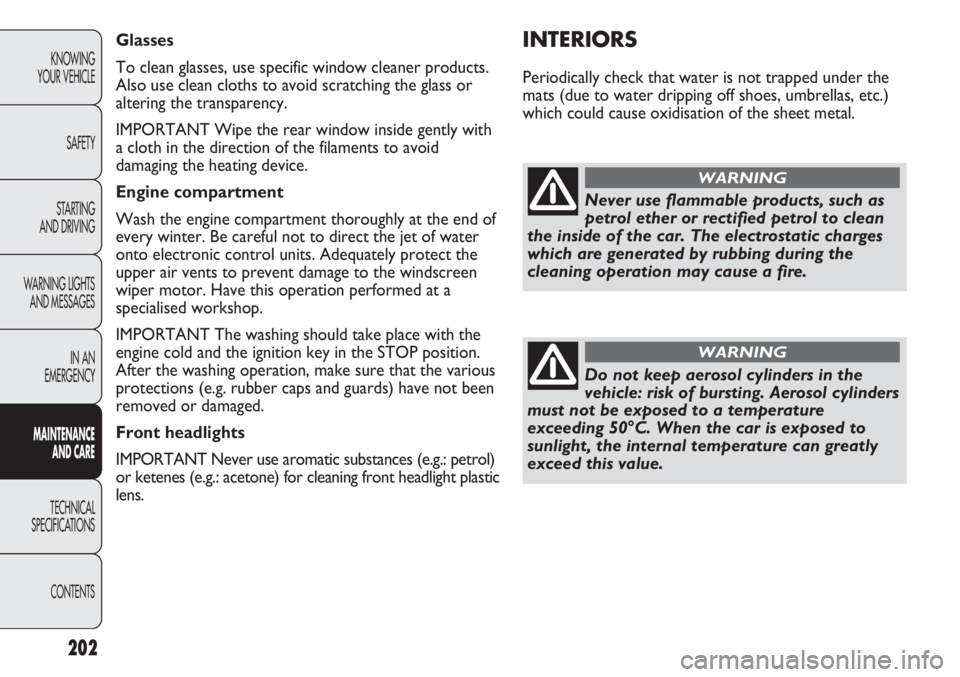
202
KNOWING
YOUR VEHICLE
SAFETY
STARTING
AND DRIVING
WARNING LIGHTS
AND MESSAGES
IN AN
EMERGENCY
MAINTENANCE
AND CARE
TECHNICAL
SPECIFICATIONS
CONTENTS
INTERIORS
Periodically check that water is not trapped under the
mats (due to water dripping off shoes, umbrellas, etc.)
which could cause oxidisation of the sheet metal. Glasses
To clean glasses, use specific window cleaner products.
Also use clean cloths to avoid scratching the glass or
altering the transparency.
IMPORTANT Wipe the rear window inside gently with
a cloth in the direction of the filaments to avoid
damaging the heating device.
Engine compartment
Wash the engine compartment thoroughly at the end of
every winter. Be careful not to direct the jet of water
onto electronic control units. Adequately protect the
upper air vents to prevent damage to the windscreen
wiper motor. Have this operation performed at a
specialised workshop.
IMPORTANT The washing should take place with the
engine cold and the ignition key in the STOP position.
After the washing operation, make sure that the various
protections (e.g. rubber caps and guards) have not been
removed or damaged.
Front headlights
IMPORTANT Never use aromatic substances (e.g.: petrol)
or ketenes (e.g.: acetone) for cleaning front headlight plastic
lens.
Never use flammable products, such as
petrol ether or rectified petrol to clean
the inside of the car. The electrostatic charges
which are generated by rubbing during the
cleaning operation may cause a fire.
WARNING
Do not keep aerosol cylinders in the
vehicle: risk of bursting. Aerosol cylinders
must not be exposed to a temperature
exceeding 50°C. When the car is exposed to
sunlight, the internal temperature can greatly
exceed this value.
WARNING
Page 204 of 270
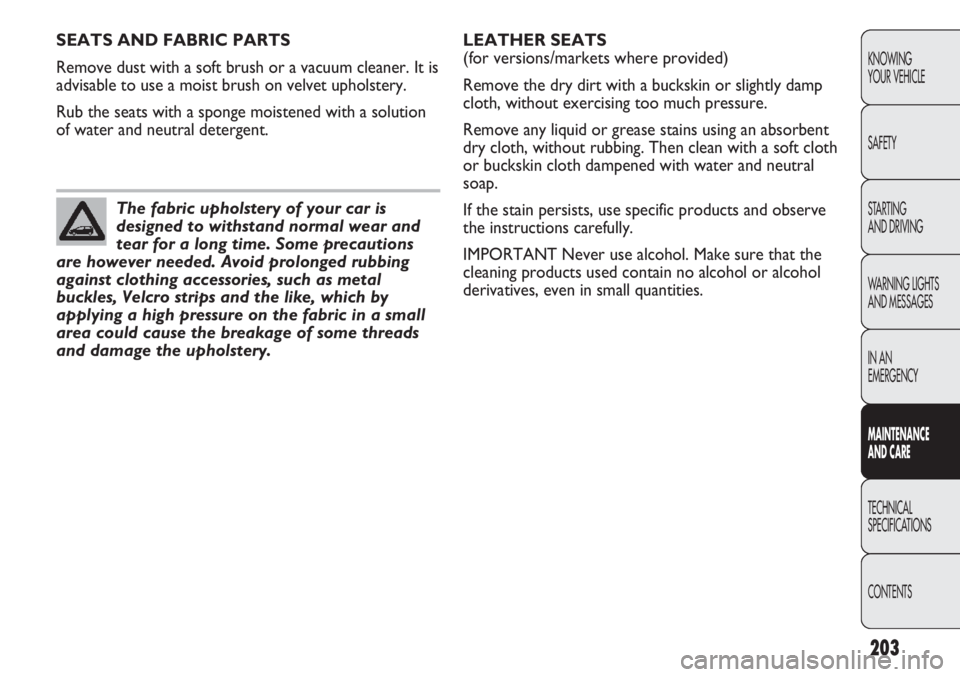
203
KNOWING
YOUR VEHICLE
SAFETY
STARTING
AND DRIVING
WARNING LIGHTS
AND MESSAGES
IN AN
EMERGENCY
MAINTENANCE
AND CARE
TECHNICAL
SPECIFICATIONS
CONTENTS
SEATS AND FABRIC PARTS
Remove dust with a soft brush or a vacuum cleaner. It is
advisable to use a moist brush on velvet upholstery.
Rub the seats with a sponge moistened with a solution
of water and neutral detergent.
The fabric upholstery of your car is
designed to withstand normal wear and
tear for a long time. Some precautions
are however needed. Avoid prolonged rubbing
against clothing accessories, such as metal
buckles, Velcro strips and the like, which by
applying a high pressure on the fabric in a small
area could cause the breakage of some threads
and damage the upholstery.
LEATHER SEATS
(for versions/markets where provided)
Remove the dry dirt with a buckskin or slightly damp
cloth, without exercising too much pressure.
Remove any liquid or grease stains using an absorbent
dry cloth, without rubbing. Then clean with a soft cloth
or buckskin cloth dampened with water and neutral
soap.
If the stain persists, use specific products and observe
the instructions carefully.
IMPORTANT Never use alcohol. Make sure that the
cleaning products used contain no alcohol or alcohol
derivatives, even in small quantities.
Page 205 of 270
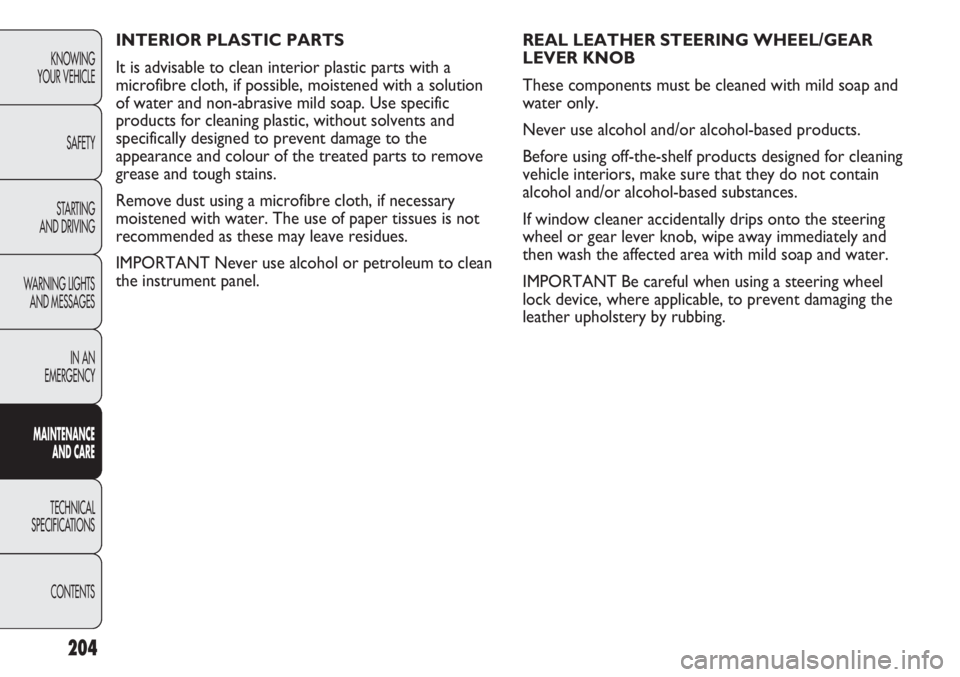
204
KNOWING
YOUR VEHICLE
SAFETY
STARTING
AND DRIVING
WARNING LIGHTS
AND MESSAGES
IN AN
EMERGENCY
MAINTENANCE
AND CARE
TECHNICAL
SPECIFICATIONS
CONTENTS
REAL LEATHER STEERING WHEEL/GEAR
LEVER KNOB
These components must be cleaned with mild soap and
water only.
Never use alcohol and/or alcohol-based products.
Before using off-the-shelf products designed for cleaning
vehicle interiors, make sure that they do not contain
alcohol and/or alcohol-based substances.
If window cleaner accidentally drips onto the steering
wheel or gear lever knob, wipe away immediately and
then wash the affected area with mild soap and water.
IMPORTANT Be careful when using a steering wheel
lock device, where applicable, to prevent damaging the
leather upholstery by rubbing. INTERIOR PLASTIC PARTS
It is advisable to clean interior plastic parts with a
microfibre cloth, if possible, moistened with a solution
of water and non-abrasive mild soap. Use specific
products for cleaning plastic, without solvents and
specifically designed to prevent damage to the
appearance and colour of the treated parts to remove
grease and tough stains.
Remove dust using a microfibre cloth, if necessary
moistened with water. The use of paper tissues is not
recommended as these may leave residues.
IMPORTANT Never use alcohol or petroleum to clean
the instrument panel.
Page 206 of 270

205
F0U180Abfig. 176
H Maximum allowed weight on second axle (rear)
I Engine type
L Bodywork version code
M Number for spare parts
KNOWING
YOUR VEHICLE
SAFETY
STARTING
AND DRIVING
WARNING LIGHTS
AND MESSAGES
IN AN
EMERGENCY
MAINTENANCE
AND CARE
TECHNICAL
SPECIFICATIONS
CONTENTS
TECHNICAL SPECIFICATIONS
IDENTIFICATION DATA
We recommend taking note of the identification codes.
The following identification codes are printed and
shown on the plates:
❒Vehicle identification number (VIN) plate.
❒Chassis marking.
❒Bodywork paint identification plate.
❒Engine marking.
IDENTIFICATION DATA PLATE
fig. 176
The data plate is located on the left side of the boot
floor and it bears the following identification data:
B Type-approval number
C Vehicle type identification code
D Chassis number
E Maximum authorised weight of vehicle fully laden
F Maximum authorised weight of vehicle fully laden
plus trailer.
G Maximum permitted weight on first (front) axle
Page 207 of 270
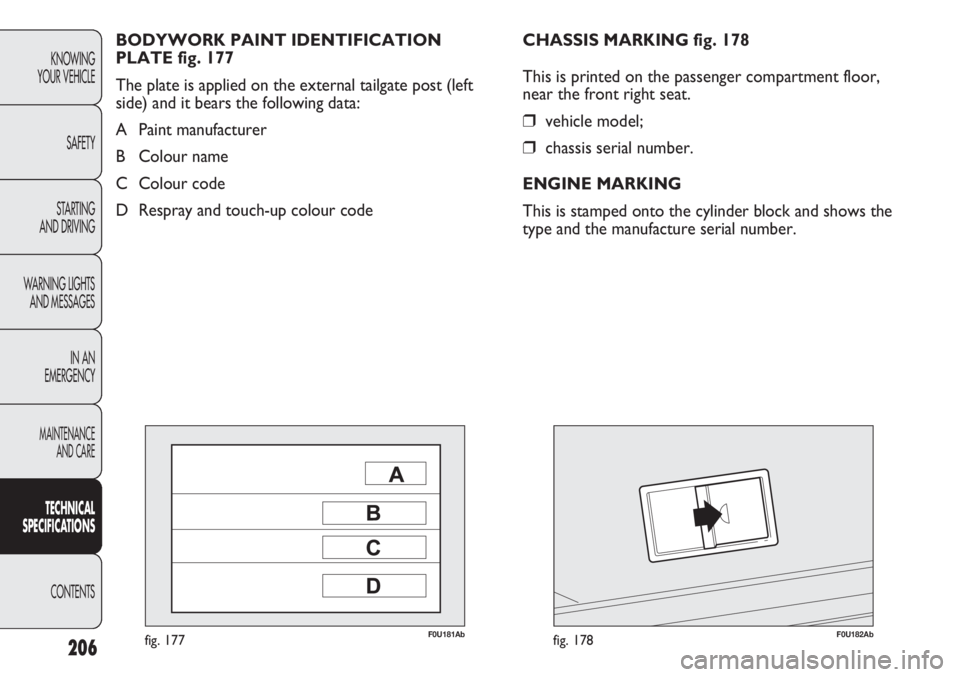
206
F0U181Abfig. 177F0U182Abfig. 178
CHASSIS MARKING fig. 178
This is printed on the passenger compartment floor,
near the front right seat.
❒vehicle model;
❒chassis serial number.
ENGINE MARKING
This is stamped onto the cylinder block and shows the
type and the manufacture serial number. BODYWORK PAINT IDENTIFICATION
PLATE fig. 177
The plate is applied on the external tailgate post (left
side) and it bears the following data:
A Paint manufacturer
B Colour name
C Colour code
D Respray and touch-up colour code
KNOWING
YOUR VEHICLE
SAFETY
STARTING
AND DRIVING
WARNING LIGHTS
AND MESSAGES
IN AN
EMERGENCY
MAINTENANCE
AND CARE
TECHNICAL
SPECIFICATIONS
CONTENTS
Page 208 of 270

207
KNOWING
YOUR VEHICLE
SAFETY
STARTING
AND DRIVING
WARNING LIGHTS
AND MESSAGES
IN AN
EMERGENCY
MAINTENANCE
AND CARE
TECHNICAL
SPECIFICATIONS
CONTENTS
ENGINE CODES –
BODYWORK VERSIONS
Version1.4 Turbo Multi Air
Type code 955A8000
Cycle Otto
Number and arrangement of cylinders 4 in line
Piston bore and stroke mm 72 x 84
Total displacement cm31368
Compression ratio 9.8 ± 0.2
Max power (EEC) kW 120
HP 163
at a speed of rpm 5500
Max. torque (EEC) NORMAL SPORT
Nm 230 250
kgm 23.4 25.5
at a speed of rpm 2250 2500
Spark plugs NGK IKR9F8
Fuel Unleaded petrol
95 RON
(EN 228 specification)
Version 1.4 Turbo
Multi Air
Engine code955A8000
Bodywork version
code (4 seats)199AXX1B47
ENGINE
Page 209 of 270

Hydraulically-controlled
Front
208
KNOWING
YOUR VEHICLE
SAFETY
STARTING
AND DRIVING
WARNING LIGHTS
AND MESSAGES
IN AN
EMERGENCY
MAINTENANCE
AND CARE
TECHNICAL
SPECIFICATIONS
CONTENTS
Modifications or repairs to the fuel supply system that are not carried out properly or do not
take the system’s technical specifications into account can cause malfunctions leading to the
risk of fire.
WARNING
Electronically controlled phased sequential Multipoint electronic injection with turbo and intercooler
POWER SUPPLY
1.4 Turbo Multi Air
Supply system
TRANSMISSION
1.4 Turbo Multi Air
Gearbox
Clutch
Traction
Six forward gears plus reverse with synchronisers for
forward gears and reverse
Page 210 of 270
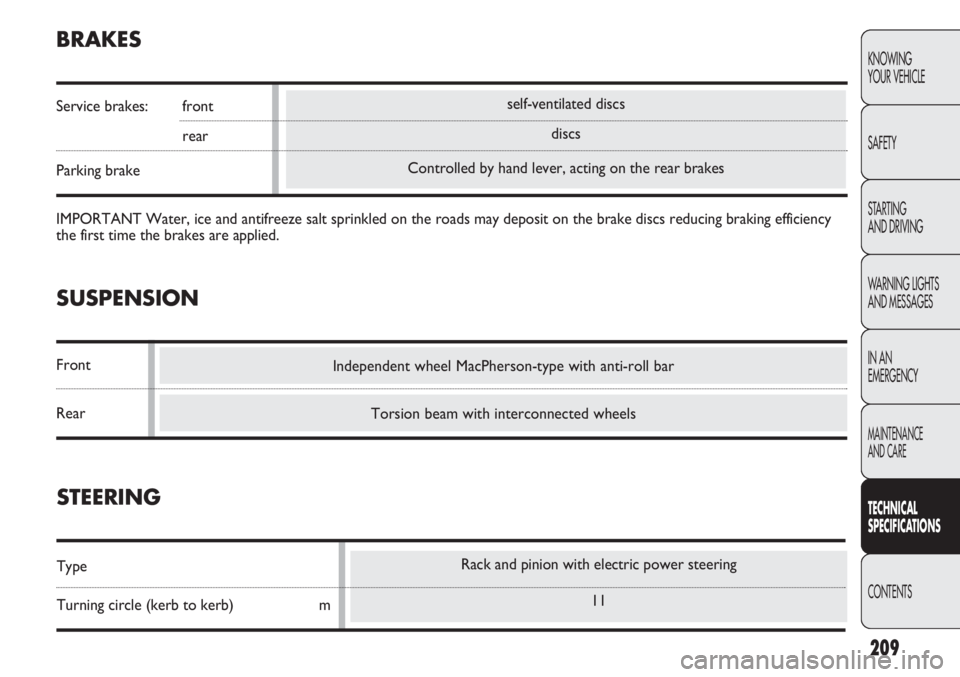
Rack and pinion with electric power steering
11
self-ventilated discs
discs
Controlled by hand lever, acting on the rear brakes
209
KNOWING
YOUR VEHICLE
SAFETY
STARTING
AND DRIVING
WARNING LIGHTS
AND MESSAGES
IN AN
EMERGENCY
MAINTENANCE
AND CARE
TECHNICAL
SPECIFICATIONS
CONTENTS
Torsion beam with interconnected wheels
Independent wheel MacPherson-type with anti-roll bar
BRAKES
Service brakes: front
rear
Parking brake
IMPORTANT Water, ice and antifreeze salt sprinkled on the roads may deposit on the brake discs reducing braking efficiency
the first time the brakes are applied.
SUSPENSION
Front
Rear
STEERING
Type
Turning circle (kerb to kerb) m